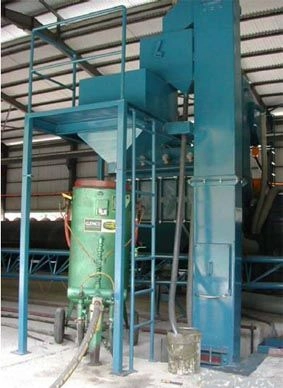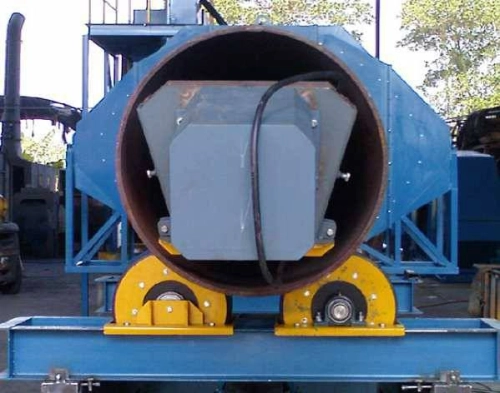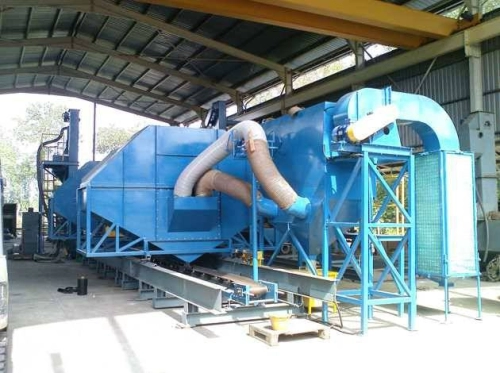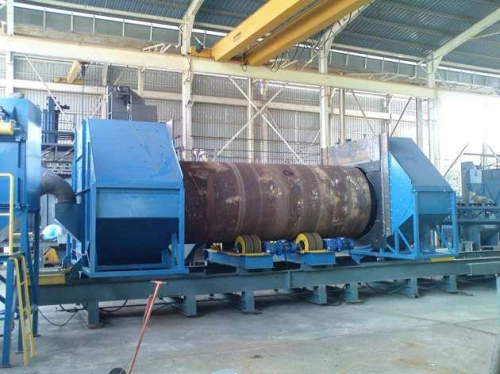Pipe Internal Surface Blasting Machine
Pipe Internal Surface Blasting Machine – Small to Big Diameter
From Nozzles Air Blast to Centrifugal Wheel Blast

We begin with the smallest pipe diameter set up for internal surface blasting. These are machines that use compressed air nozzles to propel abrasives forward to achieve the cleaning on steel surfaces.
.jpg) |
|
| An angle nozzle for straight mounting in a rotated pipe blasting set up | Circumferential cone shape blast stream for straight in & out blasting without having the pipe rotated, The centering guide is not needed in case of mounting with stiff blast lance. |
.jpg) |
||
| Long angle multiple nozzles blasting for pipe size between diameters from 12” to 30”. Such arrangement can adapt to any nozzle size. Typically multiple pieces of size 6 nozzles. | The pipe finishes appear clearly in spirally mark in rotated blasting. | An alternative tool available is a motorized air motor type variable speed rotator nozzles blasting method. Suitable for mounting of 2 size 5 nozzles |

Abrasive recovery is required for grit blasting either for small pipe or large production system. Basically,
- A chamber is needed to contain the blast stream within a closed space; - A dust collection system is needed to remove dust generated, as well as providing the ventilation required for abrasive cleaning process; - The abrasive recovery method in a close loop system is best suited for efficient use of the abrasive for repeated use.
Wheel Blast Application for Pipe Internal Surface Blast Cleaning
.jpg) |
| Large diameter & long pipe with large surface area requires fast production setup using wheel blast system where abrasive flows of up to 7 ton/hr can produce 2.5m2 of cleaning per minute. |
Pipe Internal Blasting System Projects Reference
| Pipe | |
| 2002C424Laksana | 2003C539Pipetech |
| Air nozzle | Air nozzle |
| SgBulohLinHup | MeruIntgrPipe |
| Air nozzle | Air nozzle |
.jpg) |
.jpg) |
| Air nozzle | Air nozzle |
.jpg) |
.jpg) |
| Wheel blast | Wheel blast |
.jpg) |
.jpg) |
| Wheel blast + Air nozzle | Wheel blast |
| 2018WT96ChronoDawao | 2019Wt97EDuctilePipe |
| Wheel blast + Air nozzle | Wheel blast + Air nozzle |
| 2021Wt99WeidaKuching | |
| Wheel blast + Air nozzle | |
Pipe Internal Wheel Blast System
Work Size from 0.7m to 3m diameter x 12m long Pipe
Steel pipe internal surface blasting is becoming important requirement before coating works. High performance painting system is applied and required the blasted surface to achieve at least SA2.5 Std cleanliness. Shown below is a typical system specially designed and constructed on a turnkey basis for pipe manufacturers.
 |
| Equipment is designed to blast the pipe at faster than 2 sq m per minute to the standard required in dust free condition |
WEBLAST has successfully commissioned the blasting of internal steel pipe in an automated line several years back with compressed air blast system to wheel blast that is 10 times quicker in production. A faster production speed needed by the pipe manufacturers to synchronize their production line operation that involves the spiral pipe forming, hydro-static test, external surface blasting and then comes the internal surface cleaning.
 |
Blast wheel enters the pipe being rotated where a high volume supply of abrasive is fed into it. Blasting is achieved with controlled movement of the variable blast stream covering the full pipe length. Spent abrasive is recycled with a system of blow-off action, captured and returned for recovery through a combination of conveyor belt, screw conveyor, bucket elevator, separator cleaning and a holding tank.
 |
| The system is never complete without a dust collector system installed, ensuring a clean dust free environment. |
Capabilities and Specifications of Internal Wheel Blast System
1.0 INTRODUCTION
1.1 General:
- The description below is for the WBM PxxInt Pipe Internal Blast Cleaning System.
- The facility consists of the following major equipment:
- Auto-blast Module
- Pipe Blasting Station
- Abrasive Recovery Module
- Dust Collector & Ducting System
- Control Panel/Electrics
- The lance mounted wheel blast machine is push button controlled for motors operation with interlocks for abrasive recovery and control. Blasting is normally continuous from one end to the other end of the pipe with manual pneumatic-actuated abrasive valve for continuous presence of work in the machine.
- The wheel blast machine utilizes a combination of steel shot and grit. Dust generated by the machine is being collected by the pulse-jet cartridge-type dust collector.
- Model CDC8, cartridge dust collector is installed with the machine.
2.0 TECHNICAL SPECIFICATIONS:
2.1 GENERAL DESCRIPTION:
- The ''WBM''-''Model PxxInt is a compact lance mounted airless blast cleaning machine utilizing high velocity centrifugally thrown metallic abrasives into the internal surface of the pipe . One variable speed lance and belt conveyors is provided to handle the components. The ''PxxInt'' is ideally suited for complete-coverage blast cleaning of pipes internal surface. The machine is generally in accordance to the following specifications.
- The maximum height above ground is 5.1m to the top of the elevator casing. Access ladders and platforms are included to allow maintenance procedures to take place without any difficulty.
- A complete set of ducting is provided, however, this assumes that the machine and dust collector will be situated in a position close to the machine.
- All the electric wiring from the motors to the control panel is included with the installation, again assuming the control panel is situated close to the machine.
2.2 AUTO-BLAST MODULE
- 2.2.1 Blast Wheel Unit
- Each blast wheels for small and big pipes are mounted on separate blast lances. The 7.5kw 2900rpm motor with wheel diameter of 330mm is for pipe range from 600 to 800mm, whereas wheel diameter 400 is for large pipe and using 11-15kw 2900rpm motor. Blast wheels used are capable of handling between 5 to10 ton/hr of steel abrasives. Blasting rate of the wheel is between 1.5 to 2.5 m2/min with respect to various pipe sizes.
- 2.2.2 Abrasive Feed Conveyor System
- The feed conveyor is a trough belt conveyor, formed like a semi circle at the center section to carry abrasives fast forward to the blast wheel feed chute intake.
- 2.2.3 Blast Wheel & Support Lance Structure
- The blast wheel assembly is mounted at the end of a 10m long cantilever lance structure. The lance structure is specially constructed to fit in the belt conveyor and blow-off ducting system.
- Although the feed belt lance structure is moving in and out of the pipe, the abrasives discharge from storage tank to the belt is always fixed at one point nearer the front pipe end.
- 2.2.4 Carrier Boogie Truck
- The boogie truck carries the blast head lance structure with a counter weight on the opposite end.
- The truck runs on a twin floor tracks. It is mounted with a 10HP high pressure blower unit.
- Blasting rate is controlled with a variable speed drives on the heavily constructed track rollers.
2.3 Pipe Blasting Station
- 2.3.1 Pipe Loader & Rotator
- Refer to the schematic layout for the system. Pipe rolls into a lifted flat, center with the pipe rotators. The pipe is then lowered to contact rotator rollers, while the lifter lowers to become a ‘V’, clearing the external pipe surface for the pipe free rotation. The ‘V’ top end is constructed to become a stopper to prevent accidental roll in of stand-by pipe.
- 2.3.1 Pipe Ends Enclosure
- Pipe ends enclosures are needed to ensure capture of flying of blasting stream. The front pipe-end enclosure captures the blast stream at the beginning of blasting a pipe. The far pipe-end enclosure captures the continuous blast stream from the beginning to the end. Dust ventilation duct is installed at the far end enclosure.
2.4 Abrasives Recovery Module
- 2.4.1 Abrasives Blow-Off Along Directional Blast Stream
- Successful removal of abrasives from the pipe internal length is critical for effectiveness of productive works. While the blast wheel is positioned at an angle to direct the momentum of the abrasives forward in one direction, high velocity air flow maintain the forward momentum of the abrasives and assist in bringing it out of the pipe being blasted. The system assures continuous recovery while blasting is in progress.
- 2.4.2 Abrasives Recovery Belt Conveyor
- The recovery belt is again a trough belt conveyor built with lesser trough but longer length, to cover the full length of the enclosures locations to the cross screw conveyor.
- 2.4.3 Cross Screw Conveyor
- The cross screw conveyor diverts the abrasives from the center line of blasting movement, and brings it to the bucket elevator unit mounted beside.
- 2.4.4 Bucket Elevator
- The bucket elevator brings the abrasives, fines and debris up and discharges to the wind shift separator.
- 2.4.5 Wind Shift Separator & Storage Tank
- The wind shift separator retains the course debris; separate the non-productive fines, channel airborne dust to the dust collector, and let the good abrasives goes through the screen to the storage tank. The storage tank discharge is control & is adjustable for the flow of abrasives to the blasting feed.
2.5 Dust Collector & Ducting System
- A dust collector with a flow capacity of 4000CFM is connected to the far pipe-end enclosure through ducting and abrasives trap. The system serves to carry out dust removal and assist in abrasives recovery. Cartridge type collector unit is used for its large filter area, hence low air to cloth ratio. The exhaust of the dust collector is further installed with an after filter that effectively lowers the dust emission level acceptable for inside factory installation.
2.6 Control Panel/Electrics
- All electrical equipment is suitable for operating on 440 volts, 3 phase, 60 cycle supply. Total requirement is 60 kilowatts.
- The electrical control panel is floor mounted, dust and damp protected to BS 587 type 1A. It contains all starters, contactors and appropriate fusing arrangements. The control consul is fitted with ammeters and stop/start pushbuttons to control the operating sequence automatically.
- A small PLC is installed for automatic sequence pulse cleaning of dust collector filter cartridges.
Technical SPECIFICATION
| Machine Model | P1615 | P2415 | P3630 | P4830 | PXX40 |
| Pipe diameter (mm) | 50-450 | 100-650 | 150-1000 | 150-1250 | 500-1800-3050 |
| Max pass speed (m/min) | 4 | 3 | 2.5 | 2 | 2 |
| Min pass speed (m/min) | 2 | 1.5 | 1 | 0.8 | 0.5 |
| Type of conveyor 12mL | Diablo Rolls | D200 Rolls | D360 Rolls | D360 Rolls | D360-D500 Rolls |
| Other Features | Material loader un-loader, no pit or very shallow pit design | ||||
Brochures for downloads
| PipeIntBlastDevice.pdf | Type of internal pipe blast devices |
| PipeInternalWB.pdf | Pipe internal wheel blast system |







